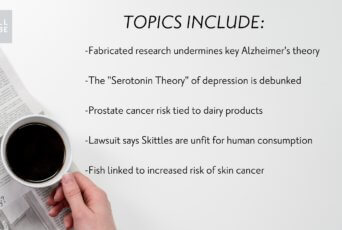There’s perhaps no piece of health (or life) advice more universally accepted than “wear sunscreen.” And yet, it’s actually a whole lot more complicated than those two simple words might imply. Sure, sunscreen helps shield you against skin cancer and other harmful effects of the sun, but the truth is that exposing our skin to the sun for at least some part of each day is important and that not all sunscreens are created equal — and some might be seriously harmful to your health. In this guide, we look at sunscreen ingredients to avoid, the best non-toxic sunscreen choices, the risks of too much sunscreen, natural sunscreen alternatives, and more.
Listen to this guide on The getWellBe Podcast.
The Case for Sunscreen
First, let’s talk about why we’re all told to wear sunscreen. The need for vitamin D which we get mostly from sun hitting our skin is irrefutable. So we’re seeing a shift in the recommendations from “never let your skin see the sun” to “protect yourself from sun damage” i.e. too much sun exposure and exposure to the sun when it’s too strong.
According to the National Cancer Institute, the rate of new melanoma (skin cancer) cases in the United States has tripled since the 1970s. Currently, an estimated one in five Americans will develop skin cancer in their lifetime, and in the U.S., more than 7,000 people die from melanoma annually. One of the main risk factors for this is too much sun exposure: studies have shown that UV radiation from the sun makes it much more likely that a person will develop melanoma and other skin cancers.
The FDA has also done some work to ensure that the sunscreens on the market are actually protecting people from skin cancer. In 2019, they laid out new regulations to better protect consumers, and in 2020, those regulations were signed into law. They include the requirements that all sunscreen products list their active ingredient on the front, and that all products with an SPF of 15 or above provide broad-spectrum protection against UVA/UVB rays, among others. However, that doesn’t mean that all sunscreens are good for your health. Let’s get into why.
Sunscreen Ingredients to Avoid
Before we get into specific sunscreen ingredients to avoid, it’s important to understand that all sunscreens fall into one of two categories: chemical or mineral. Mineral sunscreen formulas sit atop your skin to create a physical barrier against the sun, while chemical sunscreen formulas — which account for most sunscreens on the market — use chemical UV filters to protect your skin from the sun’s rays.
When we talk about sunscreen ingredients to avoid, we’re almost exclusively referring to those found in chemical sunscreens. That’s because the chemical UV filters they use are rapidly absorbed by the skin, your body’s largest organ. Several of these chemical UV filters appear to be endocrine disruptors, meaning they may interfere with your hormones, which can then create all sorts of other chronic health issues and diseases. According to the World Health Organization, endocrine disruptors are suspected of being associated with:
- altered reproductive function in males and females
- increased incidence of breast cancer
- abnormal growth patterns
- neurodevelopmental delays in children
- changes in immune function (compromising your immune system and ability to fight off infections)
This is all pretty concerning. It’s especially troublesome in the case of sunscreen for children and babies, who are much more vulnerable to toxic chemicals. What’s more, many baby sunscreens advertised as “organic” and “natural” actually contain some of the most harmful chemicals. What’s more, as we reported in a wrap-up not too long ago, chemicals from sunscreens accumulate in the body at high levels, reaching concentrations that are far greater than the FDA’s safety threshold.
Most chemical sunscreens have a long list of ingredients, so it’s important to become familiar with the most harmful ones so you can spot them. Here’s a fairly comprehensive list of sunscreen ingredients to avoid:
- Avobenzone: This ingredient is a known endocrine disruptor that can reduce coral resilience against rising ocean temperatures — meaning it’s bad for your health and for the planet. It’s been banned in Hawaii but is still common in many sunscreens.
- Benzene: An online pharmacy and pharmaceutical testing company recently detected high levels of benzene in 27% of the sunscreen and after-sun care products that they tested, with some containing levels up to three times the FDA limit. According to the CDC, the WHO, and other organizations, benzene is known to cause cancer and can be absorbed through the skin. (Side note: the same company also found high levels of benzene in several different brands of hand sanitizer that consumers snapped up during the early days of the pandemic.)
- Homosalate: Studies have shown that homosalate can mimic hormones and alter the endocrine system.
- Octinoxate: This chemical can cause moderate to severe skin allergies, and has been shown to alter hormone function. Even scarier is that it’s been detected in breast milk, meaning extra vulnerable infants are exposed.
- Octisalate: While there aren’t any studies conclusively tying this ingredient to health risks, according to the EWG there is also insufficient data to deem it totally safe. A study from the FDA found that those who had used sunscreen containing octisalate had blood levels of the ingredient that were 10 times the cutoff for exposure.
- Octocrylene: Though octocrylene itself isn’t known to harm human health, researchers recently found that as it ages over time (either on a shelf in the store or in your home), it degrades to form the dangerous compound benzophenone. Benzophenone is a known endocrine disruptor and carcinogen, and octocrylene itself, while not harmful to humans, is a potential allergen and isn’t biodegradable. The researchers found octocrylene in various different popular brands — think L’Oreal, Coppertone, Neutrogena, and many more — including some sunscreens meant for kids.
- Oxybenzone: This is a very common ingredient in sunscreen and has been linked to allergic skin reactions, endometriosis in women, and disruption of reproductive hormones — and the CDC has detected it in more than 96% of Americans. Yikes.
- Para-aminobenzoic acid (PABA): This ingredient has been linked to allergic dermatitis and can be toxic at high doses.
The risks of certain sunscreen ingredients don’t stop with human health: chemicals commonly used in sunscreens have been shown to not only disrupt human hormones, but also harm the environment. According to the EWG, oxybenzone damages the DNA of coral larvae, leading to damage and deformation of the coral; it can also contribute to coral bleaching and coral death.
The destruction caused is so serious that in May 2018, Hawaii passed a bill prohibiting the sale of sunscreens containing oxybenzone and octinoxate, which are used in at least 70% of sunscreens today. Then several islands in Hawaii went even further and passed a bill in 2022 banning the sale of sunscreens containing avobenzone and octocrylene. In July 2019, the U.S. Virgin Islands passed a similar bill, banning all but coral-safe sunscreens which went into effect in March 2020. Key West, Florida considered a similar ban, but their governor signed a controversial bill in 2020 preventing local governments from imposing these bans. California is still considering enacting a ban that would prohibit all but coral-safe sunscreen. Other locations outside the U.S. that have enacted bans include parts of Mexico, Aruba, Bonaire, and Palau.
One other important thing to note is that, regardless of ingredients, you should avoid buying spray sunscreen. According to the EWG, when you apply spray sunscreen, you inhale any toxic chemicals that are in the spray. Your lungs are a faster highway to your bloodstream than your skin, so this can be more detrimental to your health than chemicals in sunscreen lotion. If you absolutely can’t give up spray sunscreen, try to spray it directly against the palm of your hand, away from your face, and then rub it on your body. This should at least minimize how many chemical particles are released into the air for you to inhale.
The Best Non-Toxic Sunscreen
Considering all of the scary info above, you’ll probably want to seek out a non-toxic sunscreen. The best non-toxic sunscreen choices are almost all mineral sunscreens, which the FDA generally recognized to be safe and effective. Almost all of the sunscreens that received high scores for safety from the Environmental Working Group were mineral formulas.
MIneral sunscreens are safer because they don’t penetrate the skin, and therefore can’t mess with your hormones. Of course, not penetrating your skin means that you can’t fully rub the sunscreen in, which can create a bit of a white cast on your skin, but newer products are much better at helping you avoid the ghost-look. According to the Environmental Working Group’s executive summary, there has been a dramatic increase in mineral-only sunscreens since 2007, (more than doubling from 17% of products to 41%), so it makes sense that it’s becoming easier to find a mineral-based, non-toxic sunscreen that rubs in completely.
In terms of active ingredients, the best non-toxic sunscreen ingredients you should keep an eye out for are:
- Zinc oxide
- Titanium dioxide. Note that this is classified by the International Agency for Research on Cancer as a possible carcinogen to humans, but the only studies indicating harm are when the titanium dioxide is inhalable (such as the loose particles in some cosmetic powders). When used as a sunscreen you rub on your skin, however, the mineral does not penetrate beneath the top layer of your skin and therefore can’t cause harm. However, if you use a sunscreen containing titanium dioxide, be sure to avoid it in spray form, as this can be inhaled.
For a full list of WellBe-approved non-toxic sunscreens (plus 2000+ more researched and vetted items, from clean food brands to sleep aids to beauty products and more), check out the WellBe Non-Toxic Product Database
Natural Sunscreen Alternatives
So for the sake of the environment and your health, should you skip sunscreen altogether? Not exactly — but the EWG does recommend that you think of it as a last resort. Rather than reaching for the sunscreen as soon as you head for the door, opt first for natural sunscreen alternatives.
What is a natural sunscreen alternative, you might ask? It’s fairly simple: Think about what other options you have to limit your sun exposure besides putting on sunscreen. Can you wear long sleeves and/or pants? Pack a hat? Carry an umbrella? Find some shade? All of these can be major mitigating factors that protect you from the sun without putting unsafe ingredients into your body.
You can also be wise about when you get your sun exposure. For instance, studies have shown that the sun is strongest and your body is best at synthesizing vitamin D around noon. This means that you can spend less time in the sun (which means you’ll have less risk of skin damage) while still getting the sun exposure necessary for your health.
If you’re going to be in the direct (and strong) sun for more than 30 minutes, though, and it’s too hot or impractical to wear long-sleeves and a hat, it’s a good idea to use sunscreen. In those cases, make sure you reach for a mineral formula that doesn’t contain any of the scary chemicals listed above.
The Dangers of Too Much Sunscreen
While the risk of skin cancer is real, and you can thoughtfully choose mineral-based, non-toxic sunscreen, there’s also a counterargument: that too much sunscreen is bad, because we need more sun exposure for our health to get that critical vitamin D we mentioned in the beginning of this guide.
An increasing body of research supports the notion that we need a certain amount of sunlight, and that guidelines encouraging people to stay out of the sun as much as possible are actually dangerous. One striking study of 30,000 women over the course of 20 years showed that those who avoided the sun had a whole host of health issues, including autoimmune disease and life-threatening cancers. Other research has shown that sun exposure can lower blood pressure and protect against cardiovascular disease. All of this means that too much sunscreen could actually be harming your health rather than protecting it.
One of the main reasons that sun exposure is good for your health is because it helps your body produce and absorb vitamin D, a vital nutrient. When your skin is exposed to sunlight, it turns cholesterol into vitamin D that your body can use effectively. While supplements can help improve vitamin D levels, evidence suggests that they can’t replace sun exposure.
Vitamin D plays an important role in many aspects of your health, and nearly 40% of Americans are vitamin D deficient — perhaps in part because of too much sunscreen use. This matters a lot, because vitamin D deficiency has been linked to a ton of health issues, including osteoporosis, cancer, and even depression. The importance of vitamin D came to light once again during the Covid-19 pandemic, as low levels of vitamin D were associated with more severe and more fatal cases of the virus. (Learn more about vitamin D and your health in our in-depth guide.)
The WellBe Takeaway On Sunscreen and Your Health
Sunscreen is a tricky issue. It can be incredibly important for protecting your skin from sun damage, but it’s also not as safe as many people think, and it’s likely we’ve been taught to overuse it. Here’s what to remember about using sunscreen safely and appropriately:
- Sunscreen is absorbed into your skin, which is your largest organ. This means that if there are harmful ingredients in your sunscreen, they could do damage to your health.
- Most sunscreens use chemical UV filters, some of which have been shown to be endocrine disruptors. The main sunscreen ingredients to avoid are oxybenzone, PABA, octinoxate,octisalate and, most recently, avobenzone.
- Spray sunscreens should be avoided because the spray causes you to inhale the toxic chemical ingredients, which then pass into your lungs and bloodstream quickly.
- Certain sunscreen ingredients have also been shown to harm marine life. Hawaii, parts of Mexico, the U.S. Virgin Islands, Aruba, Bonaire, and Palau have banned these harmful sunscreens, and allow only coral-safe sunscreen.
- There are non-toxic sunscreen options that don’t harm your health. Look for mineral-based products with ingredients like zinc and titanium dioxide, which aren’t absorbed into the skin. For a list of WellBe-recommended non-toxic sunscreen (plus 2000+ more vetted and researched products), check out our Non-toxic Products Database.
- For sun protection, the safest move is to choose natural sunscreen alternatives, such as covering your body with clothing, wearing a hat, or staying in the shade.
- Using too much sunscreen can also be harmful to your health, because some unobstructed sun exposure is essential to your body’s ability to function. We need a certain amount of sunlight to maintain our health, and relying solely on vitamin D supplements isn’t an adequate substitute for unfiltered sun exposure on our skin.
Do you have a favorite non-toxic sunscreen or natural sunscreen alternative? Tell us in the comments below!
Citations:
- Wendt, J. et al. Human Determinants and the Role of Melanocortin-1 Receptor Variants in Melanoma Risk Independent of UV Radiation Exposure. JAMA Dermatol. 2016;152(7):776-782
- Landrigan, P. et al. Children’s Vulnerability To Toxic Chemicals: A Challenge And Opportunity To Strengthen Health And Environmental Policy. Health Affairs Vol. 30, NO. 5.
- Kunisue, T. et al. Urinary Concentrations of Benzophenone-type UV Filters in US Women and Their Association with Endometriosis. Environ Sci Technol. 2012 Apr 17; 46(8): 4624–4632.
- Urek, S. et al. Toxicological Profile of Homosalate as Cosmetic Ingredients. Global Journal of Pathology and Microbiology, 2013, 1, 7-11.
- Downs, C. A. et al. Benzophenone Accumulates over Time from the Degradation of Octocrylene in Commercial Sunscreen Products. Chemical Research in Toxicology 2021 34 (4), 1046-1054.








COMMENTS